On Wednesday, Tesla announced that it is dropping yet another set of sensors from its electric vehicles. The latest casualty? Ultrasonic sensors, usually found embedded in the bumpers, that allow for assisted parking features.
At first, it will just be the Models 3 and Y that rely solely on cameras for the entire array of driver assists that Tesla offers. However, the automaker says that after rolling out this change globally, it will then do the same for the Models S and X in 2023.
Tesla says that despite dropping radar from its adaptive cruise control and automatic emergency braking functions—which now rely solely on cameras—its vehicles "have either maintained or improved their active safety ratings in the US and Europe and perform better in pedestrian automatic emergency braking (AEB) intervention."
However, the automaker elides the fact that its removal of radar from its EVs has resulted in an ongoing National Highway Traffic Safety Administration investigation into hundreds of cases of phantom braking—in effect, false-positive activations of the cars' automatic emergency braking system.
Tesla says that its systems will improve in performance over time and that Models 3 and Y that arrive without the ultrasonic sensors will not be capable of parking assist, autopark, summon, or smart summon. Tesla claims that these functions will be restored once its vision-only system has achieved parity with the old ultrasonic sensors.


